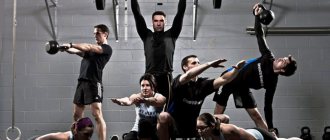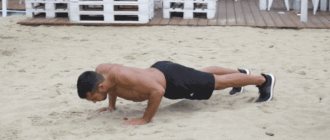- November 23, 2018
- Workouts in the gym
- Nikita Novikov
Is it possible to pump every day? Quite often you can hear the following words from many beginning athletes: “The more often I train, the faster my muscles will grow!” It is quite possible that you are one of them too. Is this approach to training effective? Can it give the desired results? In this article we will try to answer these questions in as much detail as possible. The facts presented in the article are interesting for beginners in the gym, and will allow you to learn a lot of useful information and understand the essence of the training process.
What happens if you pump every day? Debunking the Myth
Let’s not delay the introduction, but let’s say it straight away: no, you can’t pump every day. And this is not a subjective opinion, this is the opinion of all professional trainers and experienced fitness specialists. If a person lifts every day (provided that each workout is difficult), this can quickly lead to a state of overtraining, the main symptoms of which include a drop in strength indicators, psychological fatigue, lack of motivation, injuries, etc.
The claim that frequent and intense training leads to active muscle growth is a common fitness myth. This information may surprise you, but muscles do not grow during training, but during rest. During the training process, our muscle tissues are injured, and on the rest day they are restored and increase in volume. That is why it is better to work out with iron no more than 3-4 times a week.
How to choose your workout regimen
To understand how many times a week you need to go to the gym to achieve your goals, you can answer the following questions:
Experience
- I'm a newbie
- I exercise, but not regularly (b)
- The gym is my second home (c)
Age
- Up to 30 years (a)
- From 30 to 50 years (b)
- Over 50 years (c)
Nutrition
- I watch my diet (a)
- I try to eat healthy, but it doesn’t always work out (b)
- I eat whatever I want (c)
Duration of classes
- 1 hour(s)
- 60-90 minutes (b)
- No more than 30-40 minutes (c)
Type of workout
- Interval training (cardio + strength) (a)
- Mainly strength training (b)
- General strengthening activities (c)
If you want to lose weight and chose point “a” when answering most of the questions, then your best option is 3 weekly workouts lasting 45-60 minutes, provided that you watch your diet. Otherwise, you should add 1 additional workout on the weekend or a cardio run in the morning.
For those whose answers are dominated by “b”, it is enough to exercise no more than 2 times a week. Most often, the main task of those who choose this answer option is to build muscle relief. You can add 1 additional aerobic workout to their schedule, but its duration should not exceed 30-45 minutes.
Those who choose option “c” in most cases, as a rule, want to keep themselves in shape. To do this, it is enough to come to the gym 1-2 times a week for group classes or perform a set of basic exercises aimed at strengthening the main muscle groups and the cardiovascular system. People over 50 years of age are strongly advised to visit a supervising physician before starting exercise.
How much rest do you need?
Is it possible to pump every day? The only correct answer to this question has already been provided. But another question arises: “If you can’t train every day, then how much rest do you need between training sessions?” Well, let's figure it out.
On average, muscles need approximately 3 days to recover. But it is worth understanding that this indicator may vary depending on the athlete’s level of physical fitness, his training experience, as well as many other factors. If a beginner can recover after training for a week, then an experienced athlete will need only a few days.
In addition, it is also worth considering the fact that large muscle groups need more time to rest than small ones. For example, the legs take up about half the mass of all the muscles in the body, and therefore one hard workout per week will be enough for them. Arms (biceps, triceps, shoulders), on the contrary, make up about a quarter of the mass, and they need half as much time to recover as legs. But you shouldn’t think that since they regenerate faster, they need to be trained 2 times a week. This is not necessarily the case. It is worth considering the fact that small muscle groups receive a good indirect load when performing basic exercises for large muscle groups. For example, when doing pull-ups, not only the latissimus dorsi muscles are actively working, but also the biceps; The bench press works not only the chest, but also the triceps.
Factors influencing the number and intensity of training per week
The regularity and frequency of training excites almost everyone who is just starting to engage in fitness. This is indeed a very important question, depending on many external and internal factors. First of all, physiology plays a role here, and more specifically, muscle recovery time.
Recent scientific studies have proven that on average, in an adult, relatively healthy person, muscles recover after intense training over the next 48-72 hours. That is, we can say with confidence that it is better to do training with breaks of 2-3 days. Then the body will respond better to stress. However, one should not lose sight of the individual ability of the body to adapt to physical stress.
Lesson objectives
When figuring out how many times a week to train, you first need to decide why you need it.
- How often should you exercise to lose weight? To do this, you will have to exercise quite often. The more time you spend in the gym, the more often you go there, the faster the hated kilograms will go away. Moreover, the more excess weight you have at the very beginning of training, the more intensely you will have to work. In this case, it is better to create a training program based on cardio with the addition of strength training.
- To build muscle mass, you will have to slightly limit yourself. In order for muscles to have the opportunity to grow qualitatively, they will have to be given the opportunity to fully recover. Therefore, it would be optimal to plan no more than 3-4 classes per week. Appropriate strength training and light cardio will do.
- To maintain shape and physical fitness, it will be enough to do only 2-3 workouts per week.
- Age
For young people under forty, professional trainers recommend regular sports training 3-4 times a week. At a more mature age, the number of classes can be reduced to 2 times.
Fitness level
Newbies to sports and fitness often say that they find it very difficult to go to the gym four or five times in one week. But this is not at all necessary. If your physical fitness is very low, you can start with regular walks, sports or Nordic walking, and cycling. More advanced athletes can create a training program based on their level of preparedness.
Features of metabolism
Individual metabolic rates also play a big role in creating a sports schedule. It’s easiest for people who have a fast metabolism. You can do it any number of times, depending on your goals. Those who happen to be the lucky owners of a slow metabolism will have to make every effort to speed it up. This means that you will have to play sports more often.
Body type
A person’s somatotype plays an important role in how often one can and should exercise. According to scientific theory, all the various figures that exist in the world can be divided into three main subtypes.
- It is most difficult for endomorphs or people with a hypersthenic physique. They will have to train more often, put in more effort just to stay in shape.
- Mesomorphs (normosthenic type), on the contrary, have the easiest time. They very rarely suffer from excess body weight and easily acquire beautiful, sculpted muscles. Therefore, they usually need less training.
- The middle can be called ectomorphs (asthenic structure). Such people most often have a minimal amount of body fat. However, it is quite difficult for them to build muscle.
Life mode
Everyone has their own, long-established routine, which they have followed for many years. Some people easily experiment and decide to change something by setting aside time in their schedule for training, while others don’t succeed. For example, many people work late five or even six days a week. Therefore, training has to be scheduled at a later time. Choose your schedule so that important things do not interfere with your classes, otherwise you will find it difficult to stick to your schedule.
Types of training
Depending on the type of training chosen, their frequency will depend. Everything here is also tied to the goals you want to achieve. For example, beginners often don’t understand what they need or how to get started competently. It is better to alternate power and cyclic loads, performing them on different days. For example, schedule strength training on Monday, and cardio on Wednesday, no more than half an hour. On Friday, you can combine some strength training on certain muscle groups with aerobic exercise.
As the level increases, the lesson schedule can be changed at your discretion. Everything will depend on what muscle groups you need to pump. Advanced athletes typically opt for about 15-25% strength training at a high intensity level, no more is needed. You will simply work in vain or achieve overtraining, which will also not bring anything good. This means that you need to do one strength training session per week, as well as 2-4 light, calm exercises.
Many beginners sometimes ask how many times a week they need to work out their abs, legs, arms or buttocks. Here, too, everything depends on your individual form, preparedness and goals that you set for yourself. The growth of muscles and endurance, as we have already mentioned, requires rest and quality recovery. Daily exhausting exercises will not bring anything good, and even after a month you will not see not only beautiful relief, but also will not feel that you have become more prepared. Under no circumstances should you overdo it.
Optimal time to rest
You already know whether you can exercise every day and why you need rest. Now let's determine what time for rest is most optimal.
In fitness and bodybuilding, balance is very important: if you train very often, this will lead to overtraining, but if, on the contrary, you exercise rarely and without a clear plan, then you should not expect any positive results. If you do not set yourself the goal of becoming a professional bodybuilder, but are doing fitness purely for yourself, then three to four workouts a week with a rest every other day will be enough for you. So far, the best system is called a three-day split. An example of a standard three-day split: chest and biceps on Monday, back and triceps on Wednesday, shoulders and legs on Friday.
Three approaches to training frequency
Set 1 - only 3 workouts per week (1+1+1)
Train three times a week. This school is suitable for you if you are a beginner or are training to maintain your tone. By working out 3 times on different muscle groups once each, your muscles will have time to rest, and you will be happy to go to workouts. If you are a professional athlete or want to lose weight quickly, then this school is not for you.
Approach 2 - short training up to 6 times a week (2+2+2)
If you want progress, exercise 6 times a week. Beginners should not train using this system, as this can lead to overtraining, as well as unwanted injuries. You won't get good results and will most likely stop training. Again, some successful athletes and Bulgarian lifters supported this approach.
If you still choose this school, then you should not train for more than an hour. You will tire your body and your muscles will not have time to recover. Your training will not bring the desired result. And here are tips on this topic from Ekaterina Usmanova for girls to train their buttocks.
Ekaterina says that, unlike men, girls have problem areas in the hips and buttocks. Therefore, men's and women's glute workouts will be very different. Men just need to do the base to increase volume, but girls need to do the shape.
Most girls have a pear-shaped body and it is much more difficult to work out the bottom. Usmanova suggests training your buttocks 3 times a week. One workout will include a core workout (e.g., squats, lunges, deadlifts), and the other 2 workouts will focus on butt shaping and include isolation exercises.
The exercises in these workouts should be constantly varied. These can be the same squats, only without weights and for a large number of repetitions; simply the placement of the legs, abduction, extension of the legs in the simulator, and so on can change.
An exception
Is it possible to pump every day? No. Is it possible to exercise every day? Yes! And no, there is no contradiction in these words. You can exercise every day if we are talking about regular physical education, and not about heavy training. If you spend 5-10 minutes every day doing light morning exercises, this will not lead to any overtraining. Moreover, it will even benefit your body.
Lesson objectives
Most often, training is aimed at losing weight. So, how much do you need to exercise, both to lose weight and to strengthen muscles?
The main rule for effective loss of extra pounds is alternating strength exercises with breathing exercises.
So, a week you can devote 2 to 4 days to the first types of training, and devote the rest of the time to cardio exercises. Moreover, each lesson should consist of certain parts:
- warm-up – 10-15 minutes;
- main complex – 35-40 minutes;
- jogging – 15-20 minutes;
- stretching – 5-10 min.
If you are just starting your sports activities, it is recommended to start with two workouts per week and gradually increase their number to at least 4.
It is also effective to do breathing exercises, alternating them with strength exercises. The class schedule could be something like this:
- day 1 – aerobic exercise;
- day 2 – break;
- day 3 – break;
- day 4 – strength exercises;
- day 5 – break;
- day 6 – aerobic exercise;
- day 7 – break.
If you wish, you can add another strength training, but only if you are not a beginner.
Thus, you can do fitness to lose weight in different ways. Much depends on your preparedness, desire and amount of free time.
Recommendations
Since the answer to the main question of the article has already been provided, I wanted to give some useful tips that will help make training more effective and safe.
- Make a training plan. As noted above, chaotic and irregular exercise will not give any positive effect. If your goal is to gain muscle mass or lose weight, then you need to follow a well-designed training program that meets these goals.
- Eat right. Unfortunately, many athletes do not pay enough attention to their diet. The fact is that proper nutrition plays a huge role in fitness and bodybuilding (yes, no less than the training itself). If you train competently, but at the same time eat processed foods, buns and sweets, then don’t even hope to see any positive results from your workouts.
- Warm up well. Warm-up is needed to prepare the body for subsequent loads. Unfortunately, many novice athletes refuse to do it, arguing that it takes away energy and time that could be spent on the training itself. Unfortunately, such carelessness sooner or later leads to serious injuries to joints and tendons.
- Perform all exercises efficiently. Before adding a particular movement to your program, make sure that you have thoroughly studied the technique of performing it. If you do the exercise incorrectly, it will, firstly, reduce its effectiveness, and secondly, it can lead to injury.











